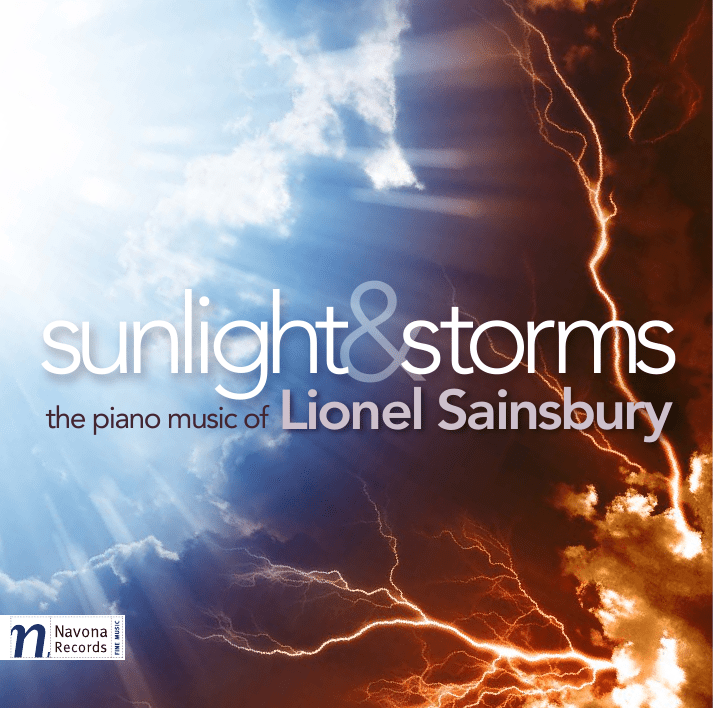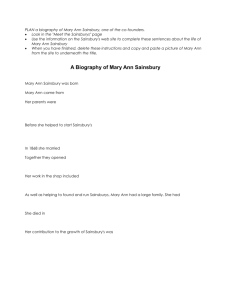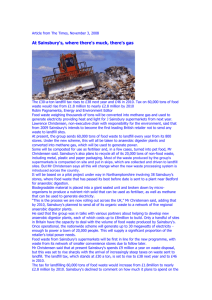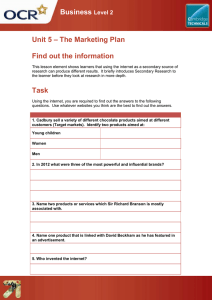sunlight storms - Navona Records

sunlight storms
the piano music of
&
Lionel Sainsbury
LIONEL SAINSBURY was born in Wiltshire, England, in 1958. He began to play the piano at an early age and soon started to compose his own music. His first serious piano lessons, at the age of 16, were with Margaret Brown, a visiting teacher at his school. He later studied composition with Patric Standford and piano with Edith
Vogel at the Guildhall School of Music and Drama in London.
At the age of 21 he was awarded a Mendelssohn Scholarship, which brought him into contact with composers as diverse as Edmund Rubbra, John McCabe and Henri
Dutilleux. Sainsbury’s music has since been performed worldwide, and broadcast on
BBC Radio 3 and Classic FM in the UK, Radio France, NHK TV/Radio in Japan, and many channels in the US.
Alongside a substantial body of piano music, Lionel Sainsbury’s catalogue to date includes works for orchestra, strings, violin, cello, guitar, clarinet, and two pianos.
Amongst artists who have performed his music are the pianists Jack Gibbons, Mark
Bebbington, Clara Rodriguez, Matthew Rickard, and the Black/Katayama piano duo; violinists Tasmin Little, Vit Mužik and Rupert Marshall-Luck, clarinetist Anna
Hashimoto, and guitarist Craig Ogden.
In 2002 his Violin Concerto was premiered at the Worcester (UK) Three Choirs Festival, with soloist Lorraine McAslan and the Bournemouth Symphony Orchestra under
Adrian Lucas. Lorraine McAslan subsequently recorded the work with the BBC
Concert Orchestra under Barry Wordsworth (Dutton CDLX 7245).
The premiere recording of Sainsbury’s Cello Concerto followed in 2012 (Dutton
CDLX 7284), performed by Raphael Wallfisch, with the Royal Scottish National
Orchestra conducted by Martin Yates.
As a performer, Lionel Sainsbury’s concerts have included the music of Bach, Scarlatti,
Chopin, Debussy, Rachmaninov and Schumann, alongside his own compositions.
3
4
The present disc surveys a wide range of Sainsbury’s piano music from 1991 through
2010. ‘Sunlight and Storms’ is certainly an apt title for such a retrospective: many of the works combine the sunlight and rhythms of South America with an emotional storminess, and indeed one of the pieces vividly depicts a storm at sea.
Sainsbury’s idiosyncratic take on the tango is displayed in his FIVE TANGOS of 2010. It is the most recent work on the disc, though the initial idea of No.2 dates back to the mid-1990s, an indication of the lengthy gestation periods typical of this composer.
No.1 reflects the passionate, extrovert aspect of the dance. Its principal themes are a lively, flowing tango melody, followed by a heavily syncopated idea that struts its stuff con forza, and a scintillating motif in double trills. A more contemplative, dreamy interlude ensues, before the first two themes return with renewed vigour.
The extended coda takes a new slant on the opening theme, with an insistent left-hand riff perhaps reminiscent of Barber. By contrast, No.2 is a languorous nocturne reflecting the sensual and dark side of the tango. Starting in F sharp major, its chromatic, yearning themes and harmonies gradually wind down to a questioning ending in remote D minor. No.3 is a fleeting, whirlwind toccata; the tango rhythm is heard briefly at the outset, then subsumed into the pianistic texture. The influence of
Ravel can perhaps be felt in the haunting No.4; it creates a hypnotic stillness, with a ghostly right hand figure repeated like a mantra throughout. The last of the set is also the most complex. Here Sainsbury abandons the tango’s 2/4 metre for freely changing time signatures. More a tango-fantasy than a strict tango, it opens with a forceful risoluto theme. There follows a searching passage in which arpeggio figures in the right hand are combined with a brooding theme in the bass. After a tense, cadenza
-like passage in single notes, the opening theme suddenly reasserts itself. Then true tango comes to the fore, with some deliciously bluesy variations, leading to an exultant maestoso peroration.
Written in 2001, CANTO OSTINATO is a latter-day Song Without Words which shows us a very different side to the composer. Its limpid melody is underpinned by a rising and falling tenor voice, imparting gentle dissonances to the harmony. The ostinato figure suggests perhaps the undulating movement of a small boat moored at the water’s edge (a gondola?).
SEA STORM was commissioned in 1997 by a friend of the composer, Simon Bell.
The opening of the piece is marked lontano (distant), with a wide-ranging left hand and slow-moving melody evoking a calm sea. In the torrential central section a pulsating left hand rhythm is pitted against tempestuous surges in the right hand.
After a coruscating climax the fury recedes, with a seamless return to the calm of the opening.
The TWO CUBAN DANCES confirm Sainsbury’s gifts as a melodist. His own arrangements of No.2 for violin and piano, and also for strings, have enjoyed widespread success - especially in the recordings by the violinist Tasmin Little and by the Royal Ballet Sinfonia. The first Dance is rhythmic and carefree, the second is pure song - punctuated by ‘strumming’ guitaristic chords.
Composed in 1998, INCANTATION opens with a hypnotic, almost trance-like theme with a somewhat oriental flavour. The central section is highly virtuosic. With rapid runs in the right hand, fiercely accented pedal notes in the bass, and a generous helping of triple forte and con tutta forza indications: Incantation becomes incandescent. The tension increases as the music drives on, with the two main themes ingeniously combined. The tumult subsides over the course of five bars, from an agitated fff to molto lento and ppp. The initial melody is now expanded and richly elaborated, before dying slowly towards a hushed close.
Sainsbury’s TEN MOMENTS MUSICAUX date from 2003. Franz Schubert seems to have been the first to have coined this title (literally Musical Moments) for a collection of short piano works: his Six Moments Musicaux were composed in 1826. Seven decades later Sergei Rachmaninov composed a set of pieces using the same title.
As far as this writer knows, Lionel Sainsbury is the first composer since then to adopt it – though it is clear that Sainsbury’s owe more to Rachmaninov than to Schubert.
5
6
No.1 provides a flamboyant opening flourish, a kind of prelude to the whole set, with fast-flowing figuration distributed between the hands, whilst No.2 is characterised by a dissonant, biting triplet figure that persists throughout. By contrast, No.3 is a bluesy, Gershwinesque song; its enigmatic, plaintive melody is heard three times, each time ascending to a higher register of the keyboard. No.4 is a fiery flamenco improvisation which harks back to the composer’s 1990 work Andalusian Fantasy
Op.16. A soulful lament is gradually engulfed by swirling figuration, which builds to a veritable storm of virtuosity rounded off with a sensational bravura coda. No.5 is a tenderly lilting habanera, although the metre is actually an alternation of 2/4 and 3/4. The jazzy No.6 could hardly be more of a contrast, with its driving energy.
Sainsbury readily acknowledges the influence in this piece of the second movement of Beethoven’s Sonata in E Op.109, though interestingly he was not conscious of it at the time of composition. E flat minor is the appropriately sombre key for No.7, the
‘dark horse’ of the set. It rises to a turbulent climax, dramatically stilled by a single off-the-beat repeated note, gradually fading to a resigned coda. No.8 bears the unusual marking ‘ondeggiante’ (undulating or swaying). It is a musical ‘jeu d’esprit’ in which rippling semiquavers are twice interrupted by an insistent declamato figure in the right hand. Siren voices seem to call from far away in No.9, in which a conflation of the blues and what the composer calls a ‘tango inquieto’ produce a mesmerising effect. No.10 is a magnificent toccata that brings the set to a conclusion with giddying virtuosity.
This selection of Lionel Sainsbury’s piano music concludes with MEDITATION , an introspective, even self-communing work, composed in 2000. In its final pages this writer finds echoes of the first of the Five Tangos, lending a neat symmetry to the disc’s programme.
© 2013 Jeremy Nicholas
Lionel Sainsbury writes: Written in the summer of 1991, my Two Cuban Dances are dedicated to Jenny Buckler. For me, they now stand as a tribute to her dear memory.
Five Tangos Op.34
.............................................................
0:00
1
2
4
5
I
II
3 III
Moderato ........................................................... 0:00
Lento ma non troppo ......................................... 0:00
Allegro molto ..................................................... 0:00
IV Lento
............................................................... 0:00
Canto Ostinato Op.30 ..................................................... 0:00
7
Sea Storm Op.24
..............................................................
0:00
8
Two Cuban Dances Op.19
I Allegretto
9 II
...............................................
Comodo ............................................................. 0:00
0:00
10 Incantation Op.26 ............................................................. 0:00
Ten Moments Musicaux Op.31
...................................... 0:00
11
12
I Molto allegro, animato ....................................... 0:00
II Risoluto ............................................................... 0:00
13 III Andante ............................................................. 0:00
14 IV Maestoso, appassionato ..................................... 0:00
15 V Sostenuto ........................................................... 0:00
16 VI Vivo .................................................................... 0:00
17 VII Moderato ........................................................... 0:00
18 VIII Ondeggiante ..................................................... 0:00
19 IX Languido ............................................................ 0:00
20 X Allegro con fuoco .............................................. 0:00
21 Meditation Op.28
............................................................. 0:00
TOTAL 0:00
Lionel Sainsbury, piano
WORLD PREMIERE RECORDINGS
7
Recorded 21 March, 16 April and 14 May 2013 at Wyastone Concert Hall, Monmouth UK
Engineered & produced by Nicholas Parker
Steinway Model D, No. 531743
Tuned & prepared by Philip Kennedy www.philipkennedy.co.uk
Photos Louise Manners
Lionel Sainsbury’s music is available from www.lionelsainsbury.com
Executive Producer Bob Lord
Product Manager Jeff LeRoy
Art & Production Director Brett Picknell
Graphic Designer Ryan Harrison
A&R Jon McCormack
PR Coordinator Ariel Oxaal info@navonarecords.com
www.navonarecords.com
223 Lafayette Road
North Hampton NH 03862
Navona Records is a PARMA Recordings company
Lionel Sainsbury recording at Wyastone Concert Hall, 14 May 2013





